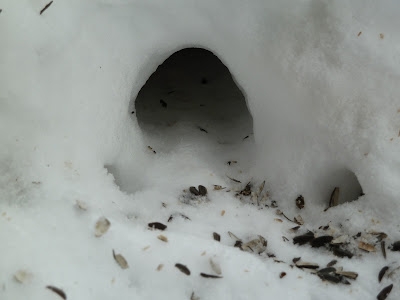 |
| Two tunnels I believe were made by red squirrels |
 |
| Snow tunnel of a red squirrel -- perhaps with a vole tunnel to its right |
Here are some photos another blogger caught of a red squirrel actually using such a tunnel. I'll keep my eyes open too, but this view of the tunnel openings isn't one I can catch without actually being outside and noticeable to the animals, and they move very quickly.
The current online issue of Audubon has an article by Jeff Hull that talks about the several layers of the snow habitat:
The article also points out that as the snow warms and refreezes in early spring there are dangerous downsides to this otherwise protective winter habitat:For many animals that don’t migrate or hibernate, snowpack provides shelter and food throughout the winter. The snow world, or nivean environment, is divided into three regions: supranivean (above the snow), intranivean (within the snowpack), and subnivean (beneath the snow). Birds such as grouse may cover themselves in powder near the surface to stay warm, while deeper snow shields mice and voles from birds of prey and foxes, coyotes, and bobcats. Tunnels that form along tree trunks and shrubs allow weasels and other small mammals to move throughout the layers. In the subnivean space, near the warmer earth, rodents such as mice and shrews graze on grass or insect eggs. And at the ground surface, fungi and bacteria communities thrive, a source of carbon dioxide that’s been recognized only in the past decade.
Earlier in the winter, depth hoar—fragile crystals with minute spaces between them—dominates the snowpack. Deer mice, voles, shrews, and weasels can move freely beneath and within it. Grouse often submerge themselves in soft snow as shelter from nighttime cold.
But spring’s isothermal conditions are dangerous for mammals below. Because the snow is water-saturated, it’s lost many of its insulating properties. A string of too-cold or too-warm days could be disastrous. “Should a real cold front move in, a cross section of snow could freeze and the animals could be trapped in there,” [naturalist JimHalfpenny, of Gardiner, Montana] says. This late in the winter, food supplies are grazed over. Being trapped in one place by an ice layer could limit the animals’ ability to forage, which could be fatal.
A sudden, sustained rise in temperature is equally dangerous. “Since water is percolating down, everything [at ground level] is pretty wet,” Halfpenny says. “In a real heavy melt, small mammals can get wet and get hypothermic—or, worse yet, drown. This can be a delicate time of the year for small mammals.”
During the heavy snows and frigid cold temperatures of the past couple of weeks, I've been particularly conscious of how difficult life must be for birds and other wildlife, but also heartened to discover the tunneling life of red squirrels and voles, which protects them from the elements and from predators to some extent. We try to keep our feeders full, make sure snow isn't clogging access to the seed, and sprinkle some seed and bread crumbs on the ground as well, to give a helping hand to those that can't perch on or cling to the feeders.
No comments:
Post a Comment